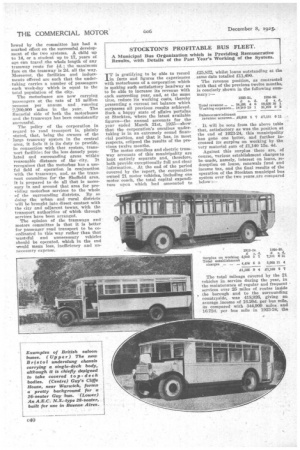STOCKTON'S PROFITABLE BUS FLEET.
Page 24

Page 25

If you've noticed an error in this article please click here to report it so we can fix it.
A Municipal Bus Organization which is Providing Remunerative Results, with Details of the Past Year's Working of the System.
IT is gratifying to be able to record in facts and figures the experiences with motorbuses of a corporation which is making such satisfactory headway as to be able to increase its revenue with each succeeding year, and, at the same time, reduce its working costs, thereby .presenting a current net balance which surpasses all previous results achieved. Such a happy state of affairs pertains at Stockton, where the latest available figures—the annual accounts for the year ended March 31st, 1925—show that the corporation's omnibus undertaking is in an extremely sound financial position, and that it has, in most respects, eclipsed the results of the previous twelve months.
The motor omnibus and electric tram. way accounts of this municipality are kept entirely separate and, therefore, both provide exceptionally full and clear information. At the end of the period covered by the report, the corporation owned 21 motor vehicles, including one motor coach, the total capital expenditure upoi L which bn d amorni ted to
£25,832, whilst loans outstanding at the same date totalled £11,490.
The revenue position, as contrasted with that of the previous twelve months, is concisely shown in the following summary:—
1928-21, 1924-25.
X s.d.£ 8. a.
'Total revenue 24,291 4 8 28,630 10 1 Working expenses._ 18,20 19 1 21,479 9 2
Balance carried toilet
revenue account._ £6,010 5 7 £1,151 0 11 • It will be seen from the above table that, satisfactory as was the position at the end of 1923-24, this municipality has gone one better, and further increased its surplus on working by the very material sum of 11,140 15s. 4d.
Against this surplus there are, of course, various establishment charges to be -made, namely, interest on loans, redemption on loans, renewals fund and income tax, and the final results of the operation of the Stockton municipal bus system over the two years are compared below :-
The total mileage covered by the 21 vehicles in service during the year, in the maintenance of regular and frequent ° services over 25 miles of routes inside the borough and to the surrounding countryside, was 418,926, giving an average income of 16.20th per bus mile, its compared with 344,909 miles and 16.72d. per bus mile in 1923-24; the
actual traffic receipts for the resrpective years being £28,283 and £24,035.
During the year 1923-24 the corporation made exhaustive tests of the possibilities of one-man-controlled buses, Leyland 26-seaters being used for -this experiment. The results were all that could• be desired, and the substantial surplus shown on the working of the buses during that period was largely due to the use of vehicles having this form of control, and it encouraged the purchase of additional vehicles of a similar type. It is clear, too, that much of the corporation's success in the past year was due to the use of such vehicles.
As is to be expected with a considerably increased mileage for the 12 months, the chief items of expenditure are in excess of those of last year, but when reduced to an average cost per bus
mile basis practically all the items show an improvement per mile run. For instance, traffic expenses last year amounted to £9,110 Os. 7d., or 5.22d. per mile, as. against £7,817 2s. Id., or 5.44d. per mile in 1923-24; whilst petrol costs totalled £4,805 12s. 2d. (2.76d. per mile), as compared with £4,109 14s. 2d. (2.86d. per mile) for the previous year. The expenses in connection with general repairs and maintenance, however, are slightly heavier, which is only to be expected with vehicles which are engaged in constant service. The figures under this head were £5,876 i2s. 9d. in 1924-25, as compared with £4,752 8s. in the previous year. It will be seen, therefore, that this increase is a relatively small one and more than balanced by the saving on the remaining items.
At the present time the Stockton Cor
poration operates the following units: Six 26-seater Leyland saloon buses (specially constructed for one-man control) ; six 30-seater All four 30-seater Bristols ; one 30-seater Leyland ; one 32-seater Stinker-Squire; one 30-seater Bristol motor coach and two 14-seater Fords. For some time past the Leyland 26-seaters have been run on pneumatic tyres with excellent results, both from the standpoints of economy and riding comfort, whilst the remaining units, which are fitted with Henley cushion tyres, have, clueing the past year, put up fine mileage records.
As was the case at the end of the previous year, the profit has been utilized in the purchase of additional rolling stock, a factor which displays a keen regard for the continued progress of the department and for the requirements of the local travelling public.
































